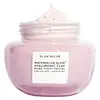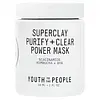What's inside
What's inside
 Key Ingredients
Key Ingredients

 Benefits
Benefits

 Concerns
Concerns

 Ingredients Side-by-side
Ingredients Side-by-side

Water
Skin ConditioningGlycerin
HumectantKaolin
AbrasiveStearyl Alcohol
EmollientHydroxypropyl Starch Phosphate
Bentonite
AbsorbentCaprylic/Capric Triglyceride
MaskingGlyceryl Stearate Se
EmulsifyingCitrullus Lanatus Fruit Extract
Skin ConditioningGluconolactone
Skin ConditioningHydrated Silica
AbrasiveSea Water
HumectantSalix Alba Bark Extract
AstringentSodium Stearoyl Lactylate
EmulsifyingXanthan Gum
EmulsifyingLactobacillus/Watermelon Fruit Ferment Extract
Skin ConditioningSodium Hyaluronate
HumectantHydrolyzed Sodium Hyaluronate
Skin ConditioningBambusa Arundinacea Stem Extract
Skin ConditioningLycium Barbarum Fruit Extract
AstringentLeuconostoc/Radish Root Ferment Filtrate
AntimicrobialCaprylyl Glycol
Emollient1,2-Hexanediol
Skin ConditioningCitric Acid
BufferingMaltodextrin
AbsorbentEclipta Prostrata Extract
Skin ConditioningGlucose
HumectantSodium Phytate
Silica
AbrasiveMelia Azadirachta Leaf Extract
Skin ConditioningPotassium Sorbate
PreservativeHexylene Glycol
EmulsifyingMoringa Oleifera Seed Oil
EmollientVaccinium Corymbosum Seed
AbrasiveHydroxyacetophenone
AntioxidantCarrageenan
CI 77891
Cosmetic ColorantPhenoxyethanol
PreservativeParfum
MaskingWater, Glycerin, Kaolin, Stearyl Alcohol, Hydroxypropyl Starch Phosphate, Bentonite, Caprylic/Capric Triglyceride, Glyceryl Stearate Se, Citrullus Lanatus Fruit Extract, Gluconolactone, Hydrated Silica, Sea Water, Salix Alba Bark Extract, Sodium Stearoyl Lactylate, Xanthan Gum, Lactobacillus/Watermelon Fruit Ferment Extract, Sodium Hyaluronate, Hydrolyzed Sodium Hyaluronate, Bambusa Arundinacea Stem Extract, Lycium Barbarum Fruit Extract, Leuconostoc/Radish Root Ferment Filtrate, Caprylyl Glycol, 1,2-Hexanediol, Citric Acid, Maltodextrin, Eclipta Prostrata Extract, Glucose, Sodium Phytate, Silica, Melia Azadirachta Leaf Extract, Potassium Sorbate, Hexylene Glycol, Moringa Oleifera Seed Oil, Vaccinium Corymbosum Seed, Hydroxyacetophenone, Carrageenan, CI 77891, Phenoxyethanol, Parfum
Water
Skin ConditioningKaolin
AbrasiveStearyl Alcohol
EmollientPropanediol
SolventGlycerin
HumectantGlyceryl Stearate
EmollientNiacinamide
SmoothingOryza Sativa Starch
AbsorbentBentonite
AbsorbentCetyl Alcohol
EmollientMagnesium Aluminum Silicate
AbsorbentMontmorillonite
AbsorbentIllite
AbrasiveCalcite
Skin ConditioningSalicylic Acid
MaskingSalix Purpurea Bark Extract
Skin ConditioningSaccharomyces/Xylinum/Black Tea Ferment
Skin ConditioningAllantoin
Skin ConditioningCarthamus Tinctorius Seed Oil
MaskingIndocyanine Green
UV AbsorberAloe Barbadensis Leaf Juice
Skin ConditioningGlyceryl Acrylate/Acrylic Acid Copolymer
HumectantCetearyl Olivate
Sorbitan Olivate
EmulsifyingTriticum Aestivum Leaf Extract
AntioxidantLactic Acid
BufferingSorbitan Stearate
EmulsifyingCaprylhydroxamic Acid
Charcoal Powder
AbrasiveSodium Citrate
Buffering1,2-Hexanediol
Skin ConditioningPhenoxyethanol
PreservativeQuartz
AbrasiveSilica
AbrasiveSodium Benzoate
MaskingPotassium Sorbate
PreservativeMaltodextrin
AbsorbentGardenia Florida Fruit Extract
Skin ConditioningWater, Kaolin, Stearyl Alcohol, Propanediol, Glycerin, Glyceryl Stearate, Niacinamide, Oryza Sativa Starch, Bentonite, Cetyl Alcohol, Magnesium Aluminum Silicate, Montmorillonite, Illite, Calcite, Salicylic Acid, Salix Purpurea Bark Extract, Saccharomyces/Xylinum/Black Tea Ferment, Allantoin, Carthamus Tinctorius Seed Oil, Indocyanine Green, Aloe Barbadensis Leaf Juice, Glyceryl Acrylate/Acrylic Acid Copolymer, Cetearyl Olivate, Sorbitan Olivate, Triticum Aestivum Leaf Extract, Lactic Acid, Sorbitan Stearate, Caprylhydroxamic Acid, Charcoal Powder, Sodium Citrate, 1,2-Hexanediol, Phenoxyethanol, Quartz, Silica, Sodium Benzoate, Potassium Sorbate, Maltodextrin, Gardenia Florida Fruit Extract
 Reviews
Reviews

Ingredients Explained
These ingredients are found in both products.
Ingredients higher up in an ingredient list are typically present in a larger amount.
1,2-Hexanediol is a synthetic liquid and another multi-functional powerhouse.
It is a:
- Humectant, drawing moisture into the skin
- Emollient, helping to soften skin
- Solvent, dispersing and stabilizing formulas
- Preservative booster, enhancing the antimicrobial activity of other preservatives
Bentonite is an aluminium phyllosilicate clay with great absorbent properties. The name 'bentonite' comes from the area where the largest source is found: Fort Benton, Wyoming.
As a clay, bentonite is often used to absorb excess oil and provide exfoliation. It has also been shown to have some antibacterial and anti-inflammatory properties. Studies show bentonite was effective at calming dermatitis from poison ivy and in diaper dermatitis of infants. Bentonite has also been shown to act as a barrier against toxic compounds on your skin.
Sunscreens containing bentonite display higher water resistance and stay on the skin for much longer. The sunscreens containing bentonite also show higher potency and UV light absorbtion.
Bentonite is naturally created from volcanic ash and several natural weathering/hydrothermal processes.
A common usage of bentonite is removing excess protein from white wines. Bentonite contains a property of being able to absorb large amounts of protein from aqueous solutions.
Phyllosilicate clay has a structure formed by sheets.
Learn more about BentoniteGlycerin is already naturally found in your skin. It helps moisturize and protect your skin.
A study from 2016 found glycerin to be more effective as a humectant than AHAs and hyaluronic acid.
As a humectant, it helps the skin stay hydrated by pulling moisture to your skin. The low molecular weight of glycerin allows it to pull moisture into the deeper layers of your skin.
Hydrated skin improves your skin barrier; Your skin barrier helps protect against irritants and bacteria.
Glycerin has also been found to have antimicrobial and antiviral properties. Due to these properties, glycerin is often used in wound and burn treatments.
In cosmetics, glycerin is usually derived from plants such as soybean or palm. However, it can also be sourced from animals, such as tallow or animal fat.
This ingredient is organic, colorless, odorless, and non-toxic.
Glycerin is the name for this ingredient in American English. British English uses Glycerol/Glycerine.
Learn more about GlycerinKaolin is a clay. It is used for oil control and to help minimize pores. Like other clays, kaolin has the ability to absorb excess sebum or oil. This can help clean out pores and mattify the skin.
Some types of kaolin may have exfoliating properties. When water is added to kaolin, it becomes a paste with small abrasive particles.
Most kaolin is a white color, but may be pink/orange/red depending on where it comes from.
The name 'kaolin' comes from a Chinese village named 'Gaoling'. Kaolin clay comes from rocks rich in kaolinite. Kaolinite, the mineral, has a silicate layered structure. Kaolinite is formed from chemical weathering of aluminum siilicate minerals.
Besides skincare, kaolin is commonly used to make glossy paper, in ceramics, toothpaste, and as medicine to soothe stomach issues.
Learn more about KaolinMaltodextrin is a polysaccharide. It is derived from starch such as rice, corn, wheat, or potato starch.
In food, Maltodextrin is used to improve the texture and thicken a product. Due to its structure, it can help create a gel texture. As an emulsion stabilizer, it helps keep the ingredients in a product together.
As a polysaccharide, Maltodextrin has moisturizing properties. Polysaccharides are a type of carbohydrate. The top layer of skin uses polysaccharides to retain water, keeping the skin hydrated.
Maltodextrin is water soluble and has a sweet taste.
Learn more about MaltodextrinPhenoxyethanol is a preservative that has germicide, antimicrobial, and aromatic properties. Studies show that phenoxyethanol can prevent microbial growth. By itself, it has a scent that is similar to that of a rose.
It's often used in formulations along with Caprylyl Glycol to preserve the shelf life of products.
Potassium Sorbate is a preservative used to prevent yeast and mold in products. It is commonly found in both cosmetic and food products.
This ingredient comes from potassium salt derived from sorbic acid. Sorbic acid is a natural antibiotic and effective against fungus.
Both potassium sorbate and sorbic acid can be found in baked goods, cheeses, dried meats, dried fruit, ice cream, pickles, wine, yogurt, and more.
You'll often find this ingredient used with other preservatives.
Learn more about Potassium SorbateSilica, also known as silicon dioxide, is a naturally occurring mineral. It is used as a fine, spherical, and porous powder in cosmetics.
Though it has exfoliant properties, the function of silica varies depending on the product.
The unique structure of silica enhances the spreadability and adds smoothness, making it a great texture enhancer.
It is also used as an active carrier, emulsifier, and mattifier due to its ability to absorb excess oil.
In some products, tiny microneedles called spicules are made from silica or hydrolyzed sponge. When you rub them in, they lightly polish away dead skin layers and enhance the penetration of active ingredients.
Learn more about SilicaStearyl Alcohol is a type of fatty alcohol from stearic acid. It is a white, waxy compound used to emulsify ingredients.
Fatty Alcohols are most often used as an emollient or to thicken a product. Emollients help soothe and hydrate the skin by trapping moisture.
They are usually derived from natural fats and oils and therefore do not have the same drying or irritating effect as solvent alcohols. FDA allows products labeled "alcohol-free" to have fatty alcohols.
Learn more about Stearyl AlcoholWater. It's the most common cosmetic ingredient of all. You'll usually see it at the top of ingredient lists, meaning that it makes up the largest part of the product.
So why is it so popular? Water most often acts as a solvent - this means that it helps dissolve other ingredients into the formulation.
You'll also recognize water as that liquid we all need to stay alive. If you see this, drink a glass of water. Stay hydrated!
Learn more about Water